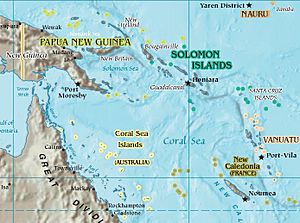Operation RY facts for kids
Quick facts for kids Operation RY |
|
|---|---|
 Map of the Coral Sea area with Nauru and Ocean (Banaba) islands in the top right corner. |
|
| Planned | April 1942 |
| Objective | Occupation of Nauru and Ocean islands |
| Date | 10 May to 30 August 1942 |
| Executed by | Imperial Japanese Navy |
| Outcome | Postponed on 15 May 1942; completed successfully on 29–30 August 1942 |
| Casualties | 1 minelayer, 1 auxiliary ship sunk |
Operation RY was a secret plan by the Japanese Empire during World War II. It aimed to invade and take control of two small islands in the South Pacific: Nauru and Ocean Island. These islands were important because they had lots of phosphate, a mineral used to make things like fertilizers and explosives.
The Japanese first planned to invade in May 1942. But they had to stop because American forces showed up. Later, in August 1942, they tried again and successfully took over the islands.
Contents
Why the Islands Were Important
Nauru and Ocean Island were small and far away, but they held a big secret: huge amounts of phosphate. This mineral was discovered around the year 1900. Phosphate was super important for making things like farm fertilizers and even ammunition for weapons.
Nauru was managed by Australia, and Ocean Island was the main office for the British Gilbert and Ellice Islands Colony. A company called the British Phosphate Commissioners (BPC) had been mining phosphate there since 1919.
Early Attacks and Defenses
Before the Japanese invasion, German ships attacked Nauru in 1940. They sank five merchant ships and damaged the phosphate mines. This made it harder for the Allies (like Britain and Australia) to get phosphate.
Because of these attacks, Australia and New Zealand sent warships to protect the islands. They even put soldiers and cannons on Nauru and Ocean Island. People also started using convoys, which are groups of ships traveling together for safety.
In February 1942, people worried that Japan might invade. So, a French warship helped evacuate, or move out, people from both islands to safety.
First Invasion Attempt
Even though a bigger Japanese plan (Operation MO) was stopped in May 1942, the Japanese navy still decided to go ahead with Operation RY.
Japanese Fleet Sets Out
On May 11, 1942, the Japanese invasion fleet left Rabaul. It was led by Rear Admiral Shima Kiyohide. The fleet included several ships, like the cruiser Tatsuta and minelayers Okinoshima and Tsugaru. There were also destroyers and heavy cruisers to protect them. The soldiers who would invade the islands were on two transport ships.
Submarine Attacks
While the Japanese fleet was sailing, a US submarine called S-42 attacked. It fired a torpedo at the `Okinoshima`, which was the flagship (the ship where the admiral was). The `Okinoshima` was badly damaged and later sank.
Another Japanese ship, the `Shoei Maru`, which was sent to help with repairs, was also sunk by a different US submarine, S-44.
Operation Called Off
Even with these losses, the Japanese forces kept going. But then, a Japanese scout plane spotted two big US aircraft carriers, USS Enterprise and Hornet, heading towards Nauru.
The US carriers were actually sent there on purpose to trick the Japanese. They wanted to make the Japanese think a big attack was coming. The trick worked! The Japanese worried their invasion force didn't have enough air protection against the US carriers. So, on May 15, they called off Operation RY and returned to base.
Second, Successful Attempt
The Japanese didn't give up. They launched a second invasion force from Truk on August 26, 1942. This time, the fleet included the cruiser Yūbari and several destroyers, along with a transport ship.
The Japanese soldiers landed on Nauru on August 29 and on Ocean Island on August 30. This time, there was no one to stop them, and they successfully took control of both islands.
Occupation of the Islands
Japanese forces stayed on Nauru and Ocean Island until the end of World War II. As the war went on, it became harder for them to get supplies and support because they were so isolated.
During the Japanese occupation of Nauru, American planes often bombed the island's buildings and facilities.

